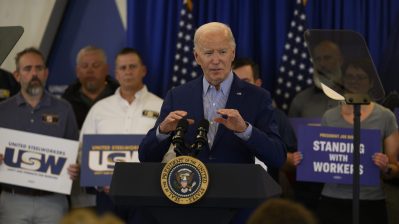How China’s one-child policy came to be
TEXT OF STORY
Kai Ryssdal: The macro-economic talk today, as we heard from Scott Tong earlier, was all about China and its currency. Beijing deciding to let the yuan float against the dollar. That decision has both global and domestic implications for the Chinese economy.
But another policy has had far more profound effects. China’s one-child policy will have been around for 30 years come this September. Hundreds of millions of Chinese are forbidden by law from having more than one child.
This week, our China correspondent Scott Tong is going to examine the social and economic effects of that policy starting today with the history of how it came to be.
People singing “March of the Volunteers,” the national anthem of China
Scott Tong: When the Communist Party took control of China in 1949, it inherited the most populous country on earth, with half a billion people — triple the population of the U.S.
Party Chairman Mao Zedong proclaimed having lots of people was “a very good thing.” It meant more workers, more soldiers for the People’s Republic. It was a matter of national pride, says anthropologist Susan Greenhalgh of the University of California, Irvine.
Susan Greenhalgh: The U.S. Secretary of State Dean Acheson, he thought the Communist regime would not be able to feed the population.
An angry Mao, she says, fired back at the nay-sayers.
Greenhalgh: And Mao said, “Of all things in the world, people are the most precious.”
But China could not feed all its people. From 1958 to 1961, 30 million starved to death from famine. Chen Meifang remembers that time well. She’s the aunt of our Marketplace assistant in China, Cecilia Chen.
Chen Meifang: In our village, we ate tree leaves and branches. We’d soak the leaves in a paste made from limestone powder, and then cooked them.
My own aunt, Luo Jiana, grew up in the 60s, and remembers hardly ever eating meat.
Luo Jiana: My family had four kids and a grandmother, so seven in all. My neighbor’s family had just two kids. It seemed they always lived better, had newer clothes and tastier food.
Shortages came largely from botched state planning, says demographer Wang Feng, at the University of California, Irvine. But the convenient scapegoat was too many people.
Wang Feng: It was not really a population issue. But the growing population actually made those problems more apparent. I think that drove the leadership to have a more forceful birth control program.
Mao speaking
Chairman Mao had changed his stance by the 70s, as China’s population passed 800 million. He now spoke of controlling growth. The government started asking people to volunteer to have fewer babies.
Che Yuelian was an early messenger, a member of a virtual army of family planning enforcers in the countryside.
Che Yuelian: The campaign was hard at the start. Villagers teased me, but I wasn’t ashamed. One year, I convinced seven women to get IUDs, six to have abortions.
Efficient enforcers won hard-cash bonuses. Parents who complied got benefits, too, including the mother of Cecilia Chen at Marketplace. Cecilia says after she was born in ’79, her mom wrote up a pledge at work.
Cecilia Chen: Saying, “I promise this is the only kid I am going to have.” She got 100 days vacation, instead of 56.
The soft sell seemed to work. During the 1970s, China’s fertility rate plunged — from about six births per woman to less than three. Still, the voluntary program was about to go mandatory. Mao had died. The new leader, Deng Xiaoping, inherited a China in the poorhouse. And demographer Wang Feng says, Deng’s regime was determined to change that.
Feng: They realized that political legitimacy rests on how they could deliver a rapid increase in standard of living. And that has to be measured on a per capita basis. So population became the denominator for everything.
Deng Xiaoping set economic targets measured by income per person. One way to get there was fewer persons. So, on Sept. 25, 1980, the one-child policy ceased to be voluntary. Parents who didn’t comply could lose their jobs; they faced hefty fines and penalties. In the early years, enforcers carried out tens of millions of sterilizations and abortions, despite resistance in the countryside.
There are exceptions to the one-child policy: Some ethnic minorities can have three kids. Most farmers are allowed two, as are families where both parents are themselves only children.
And 30 years later, the reality is inescapable. There are fewer children around. China’s fertility rate is an estimated 1.6 births per woman, one of the lowest rates in the world.
Now, was it policy? Or just urbanization? Folks who move to cities tend to have fewer children anyway. Either way, demographer Wang Feng argues the economic goals that drove the policy have been achieved. It’s time to move on.
Feng: The official document anticipated the policy will be phased out in 20 or 30 years, which is now.
He warns the policy deprives China of young people — to work and pay taxes, care for the elderly and invent things. The party line, though, is clear: The one-child policy has prevented 400 million births. And for purposes of economic growth, will remain in place.
In Shanghai, I’m Scott Tong for Marketplace.
Ryssdal: Our staff researcher Cecelia Chen contributed to Scott’s report. The series continues here all week. And tomorrow on the Marketplace Morning Report with the pressures that face an entire generation of only children.
You can trace the history of China’s one-child policy with our interactive timeline — pictures and audio here.
There’s a lot happening in the world. Through it all, Marketplace is here for you.
You rely on Marketplace to break down the world’s events and tell you how it affects you in a fact-based, approachable way. We rely on your financial support to keep making that possible.
Your donation today powers the independent journalism that you rely on. For just $5/month, you can help sustain Marketplace so we can keep reporting on the things that matter to you.


















